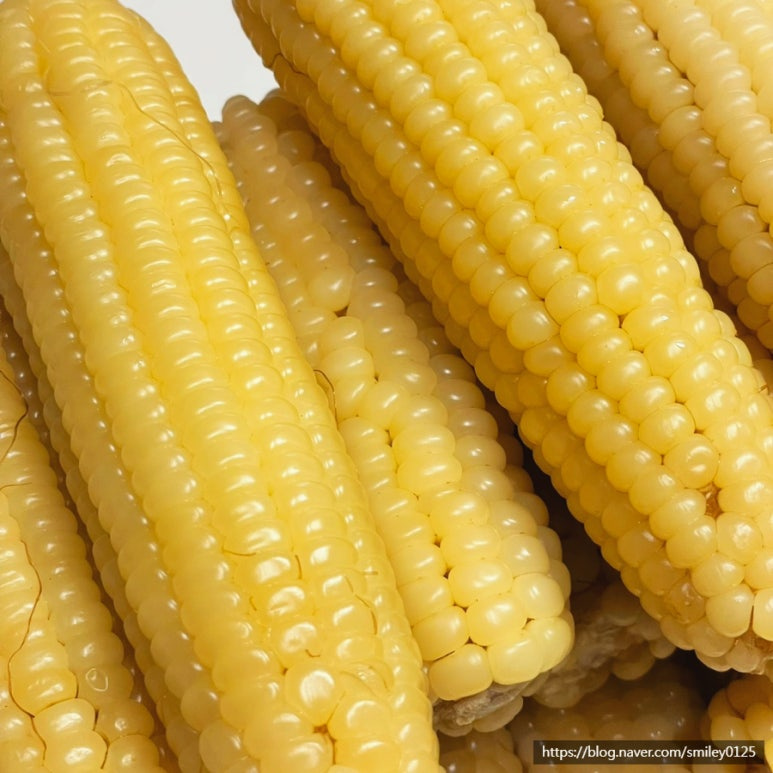Perfect Method for Boiling Sticky Corn: Sweet and Chewy Without New Sugar!
Super Simple Pot Method for Boiling Sticky Corn: Enjoy Delicious Sticky Corn Even Without New Sugar

Fresh sticky corn, bought by my husband with both hands full on his way home! We’ll show you a special way to prepare it, removing the husks and silks cleanly and boiling it in a pot until perfectly chewy and sweet, even without using new sugar. This method preserves the rich flavor and chewy texture of the corn, making it easy for anyone to enjoy delicious sticky corn.
Essential Ingredients- 5 sticky corn cobs
- 1000ml water (enough to fully submerge the corn)
- 2 Tbsp sugar (adds a subtle sweetness to the corn)
- 1 tsp salt (enhances the corn’s natural flavor)
Cooking Instructions
Step 1
Let’s start by preparing these appetizing sticky corn cobs! To capture their fresh flavor, we’ll thoroughly remove the outer husks, inner silks, and corn silks.

Step 2
Instead of peeling the outer husks one by one, it’s neater to gather them at the base of the cob and peel them off as shown in the photo. Make sure to clean the inner parts thoroughly as well.

Step 3
Now, for a magical way to remove the outer husks all at once! Firmly grip the gathered outer husks at the base with one hand, hold the corn cob with your other hand, and with a decisive twist, break it off. You’ll hear a ‘snap’ as the husks are cleanly removed along the stem.

Step 4
Pulling out corn silks one by one can be tedious, right? For the neatly bundled corn silks, gently grasp them with your hand and pull them out in one go. This will remove them cleanly without leaving strands. Ensure all silks that could interfere with the corn’s sweetness are removed.

Step 5
Here’s what the corn looks like after removing the husks and silks. You can now see the beautiful, milky kernels!

Step 6
Rinse the prepared corn under running water. While rinsing, remove any remaining corn silks or any underdeveloped kernels at the tip of the cob with a knife or your fingers for a cleaner result.

Step 7
Unlike steaming, boiling sticky corn fully submerged in water for an extended period yields a softer and more tender result. Place the prepared and washed corn cobs into the pot, layering them if necessary.

Step 8
Now, pour in 1000ml of water, ensuring the corn is completely submerged. It’s important to add enough water so that the corn isn’t exposed above the surface.

Step 9
Add 2 tablespoons of sugar to enhance the corn’s natural sweetness. Even without new sugar, it blends beautifully with the corn’s inherent sweetness for a wonderful flavor.

Step 10
Finally, add 1 teaspoon of salt to bring out the corn’s umami. The balance of sugar and salt will make the corn even more delicious.

Step 11
Close the pot lid tightly and turn the heat to high ( 강불) until the water comes to a rolling boil. Sufficient boiling time is crucial for the corn to cook through.

Step 12
Once you see the water bubbling vigorously through the lid, reduce the heat to medium-high (중강불) and boil for 30 minutes for the first stage. This ensures the corn cooks evenly.

Step 13
After the first 30 minutes, open the lid and gently turn the corn cobs over. This helps them cook more evenly. Close the lid again and continue to boil on medium-high heat for another 30 minutes for the second stage.

Step 14
After a total of 1 hour of boiling, turn off the heat, keep the lid on, and let it steam for about 20 minutes. This steaming process deepens the flavor and adds moisture to the corn. Once steaming is complete, carefully remove the corn from the pot.

Step 15
Wow! Your chewy and savory sticky corn is ready. The kernels are plump and perfectly cooked. Let it cool slightly and enjoy!

Step 16
Boiled sticky corn is best enjoyed fresh and warm. However, if you have leftovers, proper storage is key. In warm weather, it can spoil quickly if left at room temperature. To store, remove the kernels, place them in an airtight container or zip-top bag, and freeze. You can then add them to rice for corn rice, or use them in dishes like corn cheese or fritters for a delightful taste of summer.




